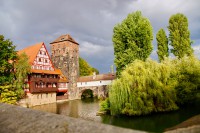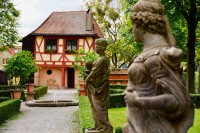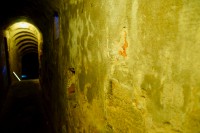
You want to explore Nuremberg with top sights in one day and the city on foot?
The programme includes breakfasts in Nuremberg's northern city, the Hesperiden Gardens, the Kaiserburg, the Lochsprison, the Nuremberg Rock Walks, Nuremberg's Old Town and a dinner in a Franconian delicacy restaurant.
I'll take you on a tour of the sights in the city center, enriched with many useful tips around Nuremberg.
Most tourists usually start their tour through the old town of Nuremberg from the main station and then stand haphazardly at the station square, try to orient themselves and then land either in Königstraße or in the craftsman's yard.
I'll show you that a tour through Nuremberg can start differently. On it goes...
Breakfast in the northern city - the Caffé Fatal
From Nuremberg Central Station I take the U3 and take the driverless subway (welcome in the digital world) to Friedrich-Ebert-Platz in Nuremberg's northern city.
From here it is only a few hundred meters to the Caffé Fatal in Jagdstr. 16. The Caffé Fatalon the ground floor of a red brick building itis lovingly furnished in the style of a Kiezcafé in a Shabby look.
Accordingly, the names of the dishes in the menu. Immediately the "Tatort Breakfast" jumps at me - espresso, Osborne 2cl and a cigarette 3,90 €.
Can do "man," but you don't have to. Instead, the choice is "Sex and the City" - cup of coffee, cava or pineapple juice, fresh fruit, cornflakes with milk, various cheeses, jam, honey, Nutella, butter, baguette for 9.90 €. I like it here, especially the relaxed handling of the staff with the mixed audience.
- Address: Jagdstr. 16, 90419 Nuremberg
The Hesperiden Gardens in the Johannis district

After breakfast, the Hesperiden Gardens in the Johannis district are on the programme.
Well hidden behind a row of houses in Johannisstraße I find this cozy place.
Usually there is not much going on here, so here rest and relaxation are guaranteed in the middle of the hectic city life.
The 6000 square metre Baroque-style garden offers a variety of sculptures inspired by Greek mythology.
The garden has the name of the legend about the Hesperides (daughters of Hesperus or the atlas).
The Hesperides had in their garden a tree with golden apples that promised eternal youth. However, the demigod Hercules was given part 12 tasks to complete, one of these tasks was to steal these apples.
Therefore, in the 17th and 18th centuries, citrus fruits were referred to by scholars as hesperides.
- Address: Johannisstraße 47, 90419 Nuremberg
- Opening hours: daily 8:00 a.m. to 8:00 p.m., from April 1st to October 31st
The Baroque Garden in Nuremberg Johannis

The HesperidenGarten officially includes the Baroque Garden, at Johannisstraße 13, just a few hundred metres further down the road towards The Imperial Castle.
With the addition of a sign on the sandstone facade, there is nothing to indicate that behind the large heavy wooden door there is a magnificent baroque garden.
With a slight creaking, the door opens and I stand in front of a horseshoe-shaped garden.
Where lemons used to bloom in the patrician era, now the Baroque blooms.
Antique sculptures and a water feature with a pummelling guy invite you to wander around.
On the stone benches you can experience peace and relaxation away from the tourist streams.
- Address: Johannisstraße 13, 90419 Nuremberg
- Opening hours: daily 8:00 a.m. to 8:00 p.m., from April 1st to October 31st
The mayor's garden at the castle

Because gardens are so beautiful, just one after - the mayor's garden behind the Imperial Castle.
I continue along Johannistraße to the big junction at the Neutorgraben, cross the junction and walk at the Neutor through the 1st archway at the Neutorturm.
The entrance to the mayor's garden is a bit hidden between the two archways, but is well signposted.
By the way, the park has its name because this part of the castle was formerly rented to the mayor.
In the park I keep to the left, in the direction of the Kaiserburg.
On winding paths lined with stairs, benches, figures, stone gates and manicured flower beds, I walk to the entrance of a gallery that allows the entrance to the city wall.
- Address: Neutorzwinger, 90403 Nuremberg
- Opening hours: Daily 8 a.m. - 8 p.m., April 1 to October 31
Views from the historic city walls

The entrance from the mayor's garden to the city wall is by the way the only public access in the entire city area.
From a gallery you have a beautiful view of Nuremberg's old town with its magnificent half-timbered houses, the Tiergärtnertorplatz, the Albrecht-Dürer-Haus, the Kaiserburg with the Sinnwell tower and the pentagonal tower with the Walburgiskapelle.
The Imperial Castle - the landmark of the city

I leave the mayor's garden and walk over the Ölberg past the restaurant Burgwächter steeply uphill to Nuremberg's Kaiserburg, the landmark of Nuremberg par excellence.
Who hasn't seen the silhouette anywhere before. From the Nuremberg Castle you have a wonderful view over the city.
Striking points are the Nuremberg TV Tower, the Sebalduskirche, Lorenzkirche, the Town Hall, Frankenstadion and the Reichsparteitag area.
A few facts about the Nuremberg Imperial Castle:
is one of the most important castles in Germany
- 1105 first mentioned in writing
- Residence of all Roman-German emperors from 1050 to 1571, at least temporarily
- is now home to one of the largest and most modern youth hostels in Germany
More information and times for the guided tours can be found on kaiserburg-nuernberg.de.
I leave the mayor's garden and walk over the Ölberg past the restaurant Burgwächter steeply uphill to Nuremberg's Kaiserburg, the landmark of Nuremberg par excellence.
Who hasn't seen the silhouette anywhere before. From the Nuremberg Castle you have a wonderful view over the city.
Striking points are the Nuremberg TV Tower, the Sebalduskirche, Lorenzkirche, the Town Hall, Frankenstadion and the Reichsparteitag area.
A few facts about the Nuremberg Imperial Castle:
- is one of the most important castles in Germany
- 1105 first mentioned in writing
- Residence of all Roman-German emperors from 1050 to 1571, at least temporarily
- is now home to one of the largest and most modern youth hostels in Germany
More information and times for the guided tours can be found on kaiserburg-nuernberg.de.

The legend of the robber knight Eppelein:
In the northern part of the castle is the moat.
Here, high above the abyss, a legend is said to have taken place:
The robber knight Eppelein von Gailingen was sentenced to death at the gallows in Nuremberg and was to be hanged on the small castle release.
As his last wish, he would have chosen to ride his faithful horse again.
According to legend, he jumped and escaped with his horse over the wall of the Nuremberg moat.
It took him a few years of life, but a few years later he was recaptured and wheeled to his death in Neumarkt.
Even today you can still discover the hoof prints of his horse in the city wall.
Maybe you find them.
The hole prisons in the old town hall

Let us stick to the atrocities that took place in Nuremberg in the Middle Ages.
From the Imperial Castle I go down to the old town hall and decide to take part in a guided tour of the Nuremberg Hole Prisons.
In the basement vault of the old town hall are the prison cells, the torture chamber, the executioner's forge and the Henkerstübchen.
It is clearly explained what happened here in the past, not for the faint-hearted.
For example, in the torture chamber there is a direct opening up into the town hall, so that the judges could also hear whether the executioner was at work.
One of the most famous Nurembergers was also detained here and branded on both cheeks.
We are talking about Veit Stoß, the well-known Nuremberg sculptor, for having forged bills, but he was able to prove that he himself was also cheated, otherwise he probably would not have gotten away with it so "glamorously".
Address: Rathausplatz 2, 90403 Nuremberg Opening times:
January & February:closed, guided tours for groups of 10 or more possible by appointment
March - October:
daily 10.00 a.m. - 4.30 p.m.
November:
Mon-Fri 10 a.m. - 4:30 p.m.
To the Christmas market:
Mon-Sun 10am-4.30pm
The beautiful fountain at Nuremberg's main market

I'm glad I'm back in daylight and now I'm going down to the main market where I'm right at the next attraction - the beautiful fountain.
The beautiful fountain has always been a trouble child of the Nurembergs, originally built in the years 1385 to 1396 from Schilfsandstein, had to be restored soon.
The last and most elaborate renovation was in 2016 and the fountain is now shining again in full splendour.
Right now as I am writing this article, I hear in the news that it needs to be restored.
why? A few weeks ago, the Red Bull District Ride took place at Nuremberg's main market and more than 20 spectators climbed onto the steel border, whereupon it bent, which is now being renovated again.
The legend of the beautiful fountain
An old legend tells of a poor locksmith who fell immortal in love with the daughter of his master.
But he rejected the liaison, saying: "Nothing will come of it! So little will come of it as you can get it, that the rings on the well grid can rotate."
But the journeyman fought for his love and made a ring, which he inserted into the grid of the "Beautiful Fountain".
Unfortunately, this story has no "happy ending", because the journeyman moved on and left his lover crying.
Even when the master regretted his mistake, the skilful locksmith remained untraceable. Since then, the legend has held that three wishes are fulfilled for the one who turns the golden ring.
On the other side of Nuremberg's main market is the Gothic Frauenkirche, which is one of the three most important churches in Nuremberg.
Charles IV founded the Frauenkirche in Nuremberg in 1355 as an imperial court chapel to store the imperial insignia, the coat and the sceptre.
But that never happened. She is best known for the "Männleinlaufen", which starts every day at 12:00 and through the prologue of the Nuremberg Christkind, which stages the opening of the Nuremberg Christmas Market.
Opening hours: Monday to Saturday 10 a.m. - 6 p.m., Sunday 1 p.m. - 6 p.m.
Tiergärtnertorplatz, Albrecht-Dürer-Haus & the historic rock walks

Continue my Nuremberg tour over the Bergstraße up to the Tiergärtnertorplatz.
A place also popular for the youth of Nuremberg and tourists.
On the corner of Albrecht-Dürer-Straße is the Albrecht-Dürer-Haus.
From 1509, Albrecht Dürer (1471-1528), Germany's most famous painter, lived and worked in the magnificent half-timbered house for almost 20 years.
Today there is a museum in it, which conveys impressions into the workshop and the artist's work.
At the other end of the Animal Garden Square is his most famous figure - the hare.
After looking at the colourful hustle and bustle on the square and having to smile a little from time to time, as tourists discussed where the Albrecht-Dürer-Haus now stands (confusion with the Franconian restaurant to the Albrecht-Dürer-Haus), I go down to the Mountain Road 19.
At this address are the Nuremberg Rock Walks and I decide to take a guided tour through the underworld of Nuremberg.
The tour lasts a good 1 hour and clearly shows how the rock passages were created, what significance they had in the past and how they served as shelters for the people of Nuremberg at the time of the Second World War.
Unfortunately, I am not allowed to publish pictures of the rock walks at this point, as this is forbidden. I can definitely recommend this tour to you.
The Executioner's Bridge - Connection between Sebald & Lorenz

Over the St. Sebalduskirche and Karlstraße I now go down to the Trödelmarkt, where the next two sights await me - the Executioner's Bridge and the Executioner's House.
Originally, the Henkersteg was built between 1320 and 1325 as a link between the two districts of Sebald and Lorenz and was called the "Langer Steg".
Only later did he get his current name, because the house of the executioner was housed in the adjacent tower.
The profession of executioner was considered dishonest at the time, which is why he was banished to the Trödelmarkt island.
The population was afraid when they came into contact with executioners, to be infected as dishonest and to be excluded from the Christian community.
Tragedy at the Executioner's Bridge
In January 1595, the Executioner's Bridge became the scene of a great tragedy.
At that time, the onset of thaw caused the Pegnitz to swell to a devastating flood.
Onlookers gathered on the executioner's walkway and watched the raging water and the ice floes floating in it.
A pillar of the Henkersteges was hit and 15 people were dragged into the Pegnitz, of which only seven could be saved.
The Weißgerbergasse - the most beautiful alley in Nuremberg

Over the Maxbrücke I now go back to the district of Sebald and go to the most beautiful alley in the whole of Nuremberg.
The Weißgerbergasse is one of the best preserved medieval streets and must not be missed on any city tour.
The alley has its name from the leather-processing craft, the White Gerber (also referred to as The Madr and Lederer) is the processing of animal skins.
A lot of water was needed for this and the Pegnitz supplied this to a sufficient extent. The waste water was of course discharged back into the Pegnitz.
At that time, this must have been a terribly smelly and dirty place. The Weißgerber were relatively wealthy, which can be seen in the elaborate half-timbered architecture of the artisan houses.
However, the profession was not particularly popular in the city, which is why residents called for the alley to be renamed Hallertorgasse.
However, the government of the Rezatkreis rejected this in 1837. Today, the alley is home to galleries and various restaurants.
We had already arrived at the last point of my sightseeing tour through Nuremberg.
